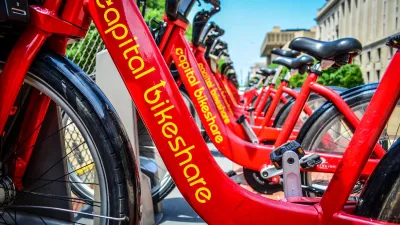In a recent piece, Kristine Johnston reviews Washington D.C.'s Capital Bikeshare program and its accessibility for low-income, non-white populations.
As featured earlier this week in the Georgetown Public Policy Review, Kristine Johnston responds to a Washington Post article highlighting the outreach Capital Bikeshare and some of its persistent barriers to reaching all of the District's population. According to Johnston, these challenges, "include language barriers, lack of money or credit among low-income residents, and limited interest in some neighborhoods." However, Johnston believes there are larger, more systemic issues as stake preventing some of the District's populations from joining Capital Bikeshare.
Mapping out bikeshare docking stations and neighborhood average yearly income, Johnston notes high densities of stations in wealthy downtown neighborhoods, with few and far between stations in those that are historically low-income. Looking further into the statistics, Johnston found that, "8 percent of Capital Bikeshare members have a household income below $35,000, while 45 percent live in households that earn more than $100,000. This compares to about 30 percent of the population in the District whose household annual income is less than $35,000, according to the 2012 American Community Survey... Only 3.5 percent of Capital Bikeshare members are African American, a group that comprises 25.8 percent of the population in the greater Washington, DC area."
In her piece, Johnston points to other research to show that, "among some low-income and minority groups there is a demand for bicycling as a mode of increased access and mobility, but there are major systemic barriers beyond affordability and access to stations that are preventing bicycling from becoming a main form of transportation in those areas."
FULL STORY: Capital Bikeshare in Low-Income Areas: The Question No One is Asking

Trump Administration Could Effectively End Housing Voucher Program
Federal officials are eyeing major cuts to the Section 8 program that helps millions of low-income households pay rent.

Planetizen Federal Action Tracker
A weekly monitor of how Trump’s orders and actions are impacting planners and planning in America.

Ken Jennings Launches Transit Web Series
The Jeopardy champ wants you to ride public transit.

Rebuilding Smarter: How LA County Is Guiding Fire-Ravaged Communities Toward Resilience
Los Angeles County is leading a coordinated effort to help fire-impacted communities rebuild with resilience by providing recovery resources, promoting fire-wise design, and aligning reconstruction with broader sustainability and climate goals.

When Borders Blur: Regional Collaboration in Action
As regional challenges outgrow city boundaries, “When Borders Blur” explores how cross-jurisdictional collaboration can drive smarter, more resilient urban planning, sharing real-world lessons from thriving partnerships across North America.

Philadelphia Is Expanding its Network of Roundabouts
Roundabouts are widely shown to decrease traffic speed, reduce congestion, and improve efficiency.
Urban Design for Planners 1: Software Tools
This six-course series explores essential urban design concepts using open source software and equips planners with the tools they need to participate fully in the urban design process.
Planning for Universal Design
Learn the tools for implementing Universal Design in planning regulations.
Ada County Highway District
Clanton & Associates, Inc.
Jessamine County Fiscal Court
Institute for Housing and Urban Development Studies (IHS)
City of Grandview
Harvard GSD Executive Education
Toledo-Lucas County Plan Commissions
Salt Lake City
NYU Wagner Graduate School of Public Service





























